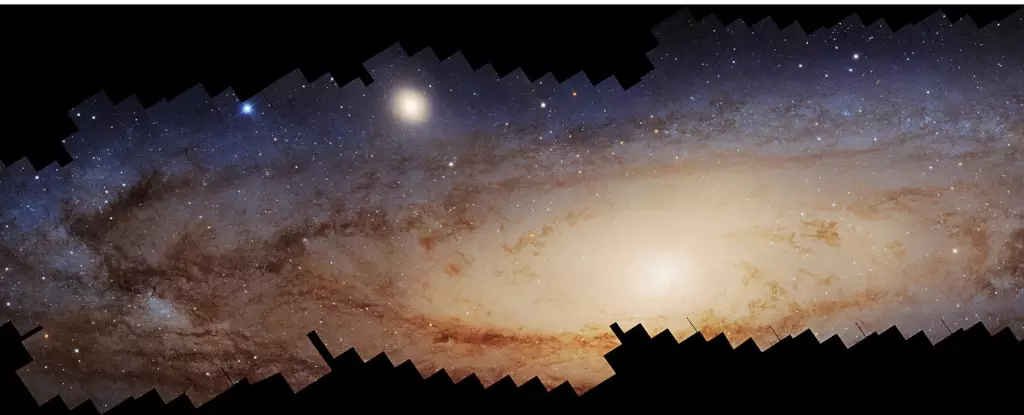The Andromeda Galaxy, also designated as M31, holds a unique position in our cosmic understanding. Being the closest spiral galaxy to the Milky Way, it serves as a critical reference point for astronomers seeking to understand the larger fabric of the universe and our own galactic structure. With its prominence in the night sky, visible as a faint grey smudge to the naked eye under optimal conditions, Andromeda serves as a direct link to the broader complexities of the cosmos beyond our Milky Way. Recent advancements in astronomical technology have allowed for unprecedented observations of M31, making its potential insights into galaxy formation and evolution more accessible than ever.
The Power of Advanced Telescopes
Notably, the Hubble Space Telescope has made significant strides in studying Andromeda, culminating in an impressive 2.5-gigapixel mosaic that captures 200 million stars within the galaxy. This endeavor, known as the Panchromatic Hubble Andromeda Treasury (PHAT), required an extraordinary commitment spanning a decade and over 1,000 orbits of the telescope around Earth. The resulting imagery provides a wealth of information about the stellar population of Andromeda, although it primarily captures brighter stars, leaving dim red dwarfs unexamined. This limitation sheds light on the challenges faced by astronomers, yet the data gathered is invaluable for assessing the health and behavior of a galaxy akin to our own.
Despite living in the Milky Way and being unable to escape its gravitational confines, researchers leverage the Hubble’s capabilities to delve into the complexities of Andromeda. Principal investigator Ben Williams of the University of Washington aptly remarks that “with Hubble, we can get into enormous detail about what’s happening on a holistic scale across the entire disk of the galaxy,” making it an indispensable tool for galactic observation.
The intricate imaging provided by Hubble not only allows astronomers to identify the myriad stars residing in Andromeda but also lays the groundwork for a deeper understanding of galactic evolution. The studies emerging from this extensive imaging effort indicate that the southern disk of Andromeda displays significant differences from the northern counterpart, hinting at a tumultuous merger history. There is a consensus among researchers that the intensity of star formation and the overall stellar architecture of a galaxy can provide clues to its violent past, and Andromeda’s distinctive features are no exception.
One of the standout components of this galactic analysis is the M32 galaxy, a dwarf galaxy likely born from a previous merger with Andromeda. Researchers speculate that M32’s existence may represent the remnants of a larger galaxy that fell victim to Andromeda’s gravitational pull. Such speculations about merger histories are crucial for understanding the architecture of galactic formation, illustrating how galaxies evolve through interactions with their surrounding environments.
The myriad observations derived from Hubble’s efforts have yielded compelling evidence for Andromeda’s complex nature. The Giant Southern Stream, identified as a tidal debris feature in Andromeda’s halo, could be indicative of ancient collisions and merges that shaped the galaxy’s current structure. Interestingly, the metallicity—the abundance of elements heavier than helium—of stars in this stream also appears to be lower than that of Andromeda’s central regions, offering more insight into the galaxy’s formation timeline.
Beyond simply cataloging stars, the cumulative data from programs like PHAT and others highlights that Andromeda exists in a state of transitions. With features resembling both star-forming galaxies and aging elliptical galaxies, M31 presents a fascinating case for studying galactic evolution over time. Insights gained suggest that Andromeda may be trending towards a stabilized state dominated by older stars, while periods of active star formation may become less frequent as the galaxy ages.
The Future of Andromeda Research
As research continues to deepen our understanding of Andromeda, astronomers eagerly anticipate the deployment of the Nancy Grace Roman Space Telescope. This upcoming mission promises to elevate observational capacity further, capturing extensive details with its advanced infrared capabilities. With a wide field of view, this instrument is poised to revolutionize how we study Andromeda and its surrounding features, including the enigmatic Giant Southern Stream.
The investigation of the Andromeda Galaxy serves not only to unravel the specific characteristics of our nearest galactic neighbor but also to provide wider context about the Milky Way itself. As telescopic technology advances and observational techniques evolve, each new glance at M31 unveils a layer of complexity, reflecting the overall grandeur of a dynamic universe teeming with possibilities. Understanding Andromeda remains an enduring mission for astronomers, reinforcing the notion that the secrets of our cosmic environment often lie right next door.

